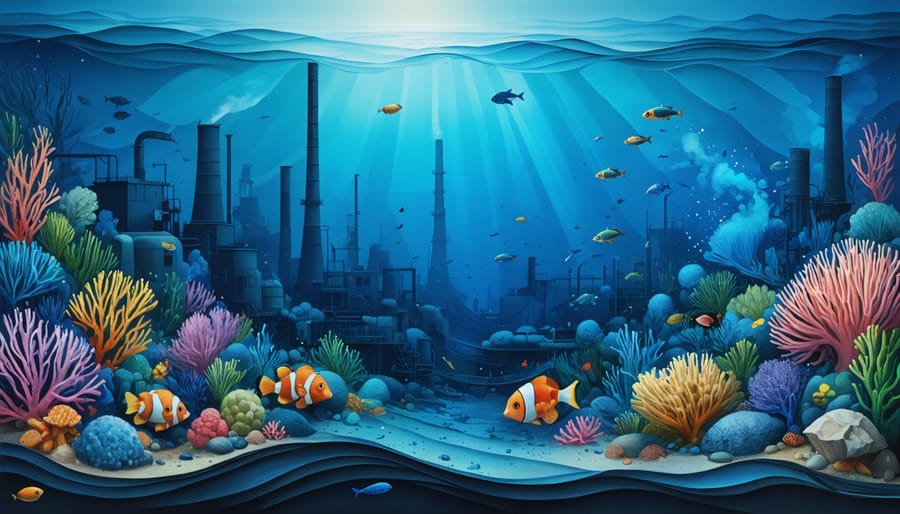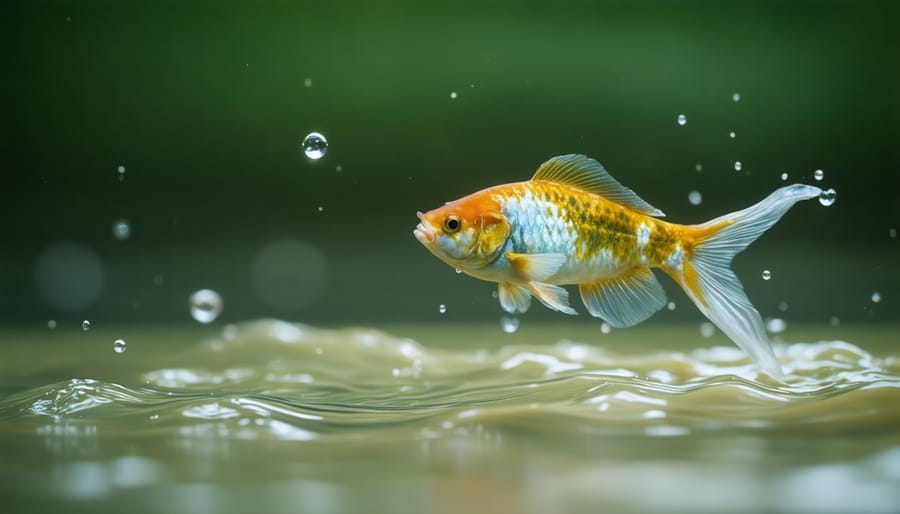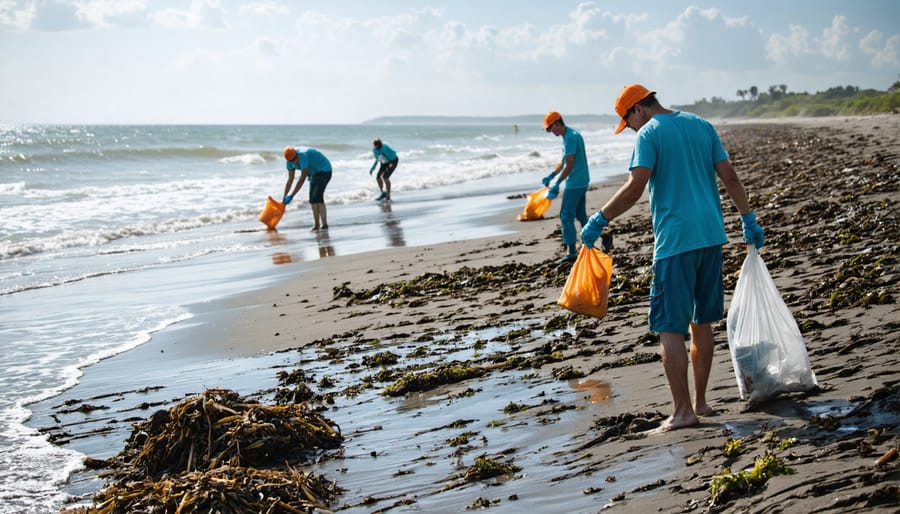
Zinc, a trace metal essential for life, is leaving an indelible mark on our oceans. As human activities release increasing amounts of zinc into marine environments through industrial waste, urban runoff, and even common products like sunscreens and cosmetics, this metal is accumulating to dangerous levels. Once in the water, zinc can be toxic to marine organisms, impacting their growth, reproduction, and survival. Sensitive species like corals and oysters are especially vulnerable. Zinc pollution also interacts with other stressors like ocean acidification and microplastics, magnifying the threats facing marine life. As zinc levels rise in step with growing coastal development and populations, addressing this invisible menace is critical to protecting the health of our oceans. By tracing zinc’s journey from land to sea, we can identify key pollution sources and implement solutions before irreversible damage is done to marine ecosystems.
Sources of Zinc in the Environment
Industrial Sources
Zinc pollution in marine environments often originates from industrial activities such as mining, smelting, and manufacturing. Mining operations extract zinc ores from the earth, which can lead to the release of zinc-containing dust and runoff into nearby water bodies. Smelting processes, used to extract zinc from ores, can emit zinc particles into the atmosphere that eventually settle in the ocean. Manufacturing industries, such as those producing batteries, rubber, and paints, may discharge zinc-containing wastewater or contribute to zinc pollution through improper waste disposal.
These industrial sources can significantly elevate zinc concentrations in marine habitats near the sites of activity. While zinc is an essential element for marine life in trace amounts, excessive levels from anthropogenic sources can have detrimental effects on marine organisms and ecosystems. Monitoring and regulating zinc emissions from industrial activities is crucial for protecting the health of our oceans. By implementing sustainable practices, such as proper waste management and emissions control technologies, industries can play a vital role in reducing zinc pollution and safeguarding marine biodiversity for future generations.

Agricultural and Domestic Sources
Zinc enters the environment through agricultural practices like the use of fertilizers and pesticides. Many fertilizers contain zinc as a micronutrient to support plant growth, while some fungicides and herbicides also include zinc compounds. When these products are applied to crops or lawns, excess zinc can accumulate in the soil and potentially leach into nearby water bodies.
In addition to agricultural sources, zinc is present in various household items that can contribute to environmental contamination. Common products like sunscreen, cosmetics, paint, batteries, and tire dust contain zinc. When these items are improperly disposed of or washed down drains, the zinc can enter wastewater treatment systems and ultimately end up in aquatic ecosystems.
Zinc from roofing materials and galvanized structures can also leach into the environment over time due to weathering and corrosion. Rainwater runoff from these surfaces can carry dissolved zinc into storm drains, rivers, and coastal waters.
While zinc is an essential element for living organisms, excessive amounts from agricultural and domestic sources can disrupt the delicate balance of marine ecosystems. It’s crucial for individuals to be mindful of their zinc footprint and properly dispose of products containing this metal. Supporting sustainable farming practices and opting for eco-friendly alternatives in our daily lives can help minimize the environmental impact of zinc pollution.
Zinc’s Impact on Marine Life

Toxicity to Marine Animals
Zinc is a trace element essential for marine life, but elevated concentrations can have detrimental effects on marine organisms. Fish are particularly sensitive to zinc toxicity, which can lead to impaired growth, reproduction, and survival. Chronic exposure to sublethal zinc levels can cause gill damage, reduced oxygen uptake, and altered behavior in fish. Invertebrates, such as mollusks and crustaceans, are also vulnerable to zinc toxicity. Elevated zinc levels can interfere with their growth, reproduction, and immune function. Oysters, for example, can accumulate high levels of zinc in their tissues, leading to reduced growth and survival.
Zinc toxicity can also disrupt the delicate balance of marine ecosystems. Phytoplankton, the foundation of marine food webs, can be adversely affected by high zinc concentrations, leading to reduced primary productivity and potential cascading effects on higher trophic levels. Moreover, the impact of pollution, including zinc contamination, can exacerbate the stress on already vulnerable marine populations facing multiple threats such as habitat loss, overfishing, and climate change.
To protect marine life from zinc toxicity, it is crucial to monitor and regulate zinc inputs into the marine environment. This involves identifying and controlling point sources of zinc pollution, such as industrial discharges and mining activities, as well as managing diffuse sources like urban runoff and agricultural practices. By implementing effective pollution prevention and mitigation strategies, we can help safeguard the health and diversity of our marine ecosystems for generations to come.
Effects on Marine Plants and Algae
Zinc pollution can have significant effects on marine plants and algae, the primary producers that form the foundation of ocean food webs. When zinc levels exceed natural concentrations, it can disrupt photosynthesis and growth in these organisms. Studies have shown that high zinc levels can reduce chlorophyll production, leading to decreased photosynthetic efficiency and slower growth rates in marine plants like seagrasses and macroalgae. This impact on primary productivity can have cascading effects throughout the ecosystem, as these plants provide food and habitat for numerous marine species.
Phytoplankton, microscopic algae that drift in the water column, are also vulnerable to zinc toxicity. Elevated zinc concentrations can alter phytoplankton community structure, favoring more tolerant species over sensitive ones. This shift in species composition can have implications for the entire marine food chain, as different phytoplankton species have varying nutritional values for the organisms that consume them. By affecting the base of the food web, zinc pollution can indirectly impact the health and abundance of higher trophic levels, from zooplankton to fish and marine mammals.
However, it’s important to note that the effects of zinc on marine plants and algae can vary depending on factors such as species sensitivity, water chemistry, and the presence of other pollutants. Some species have developed mechanisms to tolerate or detoxify excess zinc, while others remain highly sensitive. Ongoing research is crucial to better understand the complex interactions between zinc and marine primary producers, and to develop strategies for mitigating the impacts of zinc pollution on these vital organisms.
Bioaccumulation and Biomagnification
Zinc, like many heavy metals, can accumulate in the bodies of marine organisms through a process called bioaccumulation. As zinc enters the marine environment, it is absorbed by phytoplankton and other microorganisms at the base of the food chain. These organisms are then consumed by larger creatures, such as zooplankton, small fish, and invertebrates, which in turn are eaten by even larger predators. At each step in the food chain, the concentration of zinc increases, a phenomenon known as biomagnification. Top predators like sharks, tuna, and marine mammals can accumulate significantly higher levels of zinc in their tissues compared to organisms lower in the food chain. This process not only affects the health of individual species but can also have cascading effects on the entire marine ecosystem. Understanding the mechanisms of bioaccumulation and biomagnification is crucial for developing effective strategies to mitigate the impact of zinc pollution on marine life.
Mitigating Zinc Pollution
Regulatory Measures
To address the environmental impacts of zinc pollution, various regulatory measures have been put in place at national and international levels. In the United States, the Clean Water Act sets limits on the amount of zinc that can be discharged into water bodies by industrial facilities. The Environmental Protection Agency (EPA) also regulates zinc levels in drinking water and has established guidelines for safe zinc concentrations in soil.
Similarly, the European Union has implemented the Water Framework Directive, which aims to achieve good ecological and chemical status in all water bodies, including those affected by zinc pollution. The directive sets environmental quality standards for zinc and other pollutants, and requires member states to monitor and control their levels in water.
Internationally, the United Nations Environment Programme (UNEP) has recognized the need to address metal pollution, including zinc, through its Global Mercury Assessment and Global Lead and Cadmium Assessment programs. These initiatives aim to raise awareness about the risks associated with metal pollution and promote the adoption of best practices to minimize their release into the environment.
While these regulatory measures have helped reduce zinc pollution, there is still room for improvement. Stricter enforcement, regular monitoring, and increased public awareness are crucial for ensuring the effectiveness of these regulations in protecting our marine ecosystems from the detrimental effects of zinc pollution.
Sustainable Zinc Management
To minimize the environmental impact of zinc, industries can adopt sustainable management practices. Implementing closed-loop systems and recycling zinc-containing materials can significantly reduce zinc release into the environment. Treating industrial wastewater to remove zinc before discharge is crucial for protecting aquatic ecosystems. Industries should also invest in technologies that minimize zinc emissions during manufacturing processes, such as advanced air filtration systems. Proper disposal of zinc-containing waste, including batteries and galvanized steel, is essential to prevent leaching into soil and water. By adhering to environmental regulations, conducting regular monitoring, and continuously improving their practices, industries can play a vital role in mitigating the negative impacts of zinc on marine life and ecosystems. Collaboration between industries, researchers, and policymakers is key to developing innovative solutions and promoting sustainable zinc management on a global scale.
Ecological Restoration Efforts
Several inspiring marine habitat restoration projects are underway to address the impacts of zinc pollution. In Tampa Bay, Florida, scientists and volunteers have been working to restore seagrass beds damaged by industrial runoff containing zinc and other heavy metals. By transplanting healthy seagrass and monitoring water quality, they’ve seen a remarkable resurgence in marine life.
Similarly, in Australia’s Port Phillip Bay, a large-scale habitat restoration project has focused on rejuvenating oyster reefs affected by zinc contamination. The reintroduction of native oysters has not only helped filter the water but also provided crucial habitat for various species. These efforts showcase the power of collective action and offer hope for the recovery of zinc-impacted ecosystems worldwide. By supporting such initiatives through volunteering or donations, individuals can play a vital role in protecting and restoring our precious marine habitats.

Conclusion
In conclusion, the environmental impact of zinc on marine ecosystems is a significant concern that demands attention and action. Zinc pollution, primarily from anthropogenic sources like mining, industrial activities, and agricultural runoff, can have detrimental effects on marine life, including reduced growth, impaired reproduction, and increased mortality. To mitigate these impacts, it is crucial to implement stricter regulations on zinc emissions, improve wastewater treatment, and promote sustainable practices in industries. Furthermore, ongoing research and monitoring are essential to understand the long-term consequences of zinc pollution and develop effective conservation strategies. As individuals, we can contribute to the solution by supporting marine conservation efforts, making environmentally conscious choices, and spreading awareness about the importance of protecting our oceans. By working together and taking collective action, we can help preserve the delicate balance of marine ecosystems and ensure a healthier future for our planet’s incredible biodiversity.
jessica
Ava Singh is an environmental writer and marine sustainability advocate with a deep commitment to protecting the world's oceans and coastal communities. With a background in environmental policy and a passion for storytelling, Ava brings complex topics to life through clear, engaging content that educates and empowers readers. At the Marine Biodiversity & Sustainability Learning Center, Ava focuses on sharing impactful stories about community engagement, policy innovations, and conservation strategies. Her writing bridges the gap between science and the public, encouraging people to take part in preserving marine biodiversity. When she’s not writing, Ava collaborates with local initiatives to promote eco-conscious living and sustainable development, ensuring her work makes a difference both on the page and in the real world.
